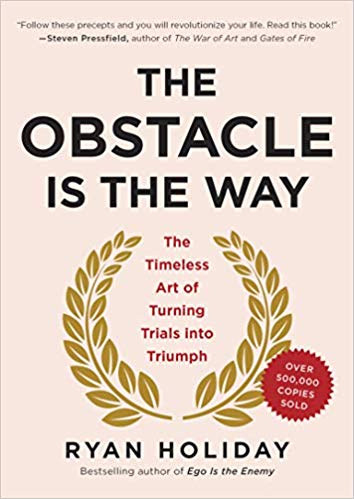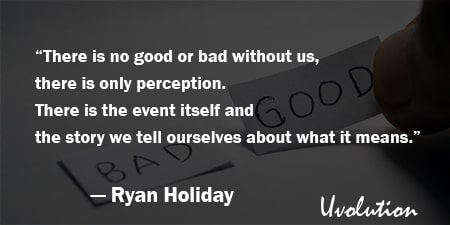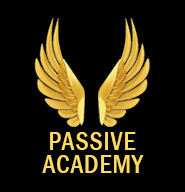The Obstacle is The Way by Ryan Holiday Summary
The Book in 1 Sentences
“Whatever we face, we have a choice: Will we be blocked by obstacles, or will we advance through and over them?
We might not be emperors, but the world is still constantly testing us. It asks: Are you worthy? Can you get past the things that inevitably fall in your way? Will you stand up and show us what you’re made of?
Plenty of people have answered this question in the affirmative. And a rarer breed still has shown that they not only have what it takes, but they thrive and rally at every such challenge. That the challenge makes them better than if they’d never faced the adversity at all.
Now it’s your turn to see if you’re one of them, if you’ll join their company. This book shows you the way.” ~ Ryan Holiday
8 BIG Ideas
The Obstacle is The Way Summary
1. What is Perception?
“WHAT IS PERCEPTION? It’s how we see and understand what occurs around us—and what we decide those events will mean. Our perception can be a source of strength or of great weakness.
If we are emotional, subjective, and short-sighted, we only add to our troubles. To prevent becoming overwhelmed by the world around us, we must, as the ancients practiced, learn how to limit our passions and their control over our lives.
It takes skill and discipline to bat away the pests of bad perceptions, to separate reliable signals from deceptive ones, to filter out prejudice, expectation, and fear.
But it’s worth it, for what’s left is truth. While others are excited or afraid, we will remain calm and imperturbable. We will see things simply and straightforwardly, as they truly are—neither good nor bad. This will be an incredible advantage for us in the fight against obstacles.”
2. What is Action?
“WHAT IS ACTION? Action is commonplace, right action is not. As a discipline, it’s not any kind of action that will do, but directed action.
Everything must be done in the service of the whole. Step by step, action by action, we’ll dismantle the obstacles in front of us. With persistence and flexibility, we’ll act in the best interest of our goals.
Action requires courage, not brashness—creative application and not brute force. Our movements and decisions define us: We must be sure to act with deliberation, boldness, and persistence.
Those are the attributes of right and effective action. Nothing else—not thinking or evasion or aid from others. Action is the solution and the cure to our predicaments.”
So, first get your mind right. Properly see the event as an opportunity to grow.
Then, take right action. Act with deliberation, boldness and persistence.
3. What is Will?
“WHAT IS WILL? Will is our internal power, which can never be affected by the outside world. It is our final trump card.
If action is what we do when we still have some agency over our situation, the will is what we depend on when agency has all but disappeared.
Placed in some situation that seems unchangeable and undeniably negative, we can turn it into a learning experience, a humbling experience, a chance to provide comfort to others. That’s will power. But that needs to be cultivated.
We must prepare for adversity and turmoil, we must learn the art of acquiescence and practice cheerfulness even in dark times. Too often people think that will is how bad we want something. In actuality, the will has a lot more to do with surrender than strength.
Try “God willing” over “the will to win” or “willing it into existence,” for even those attributes can be broken. True will is quiet humility, resilience, and flexibility; the other kind of will is weakness disguised as bluster and ambition. See which lasts longer under the hardest of obstacles.”
“If Perception and Action were the disciplines of the mind and the body, then Will is the discipline of the heart and soul.”
So, Perception + Action + Will = Turning trials into triumph.
4. Emotional Regulation
“John Glenn, the first American astronaut to orbit the earth, spent nearly a day in space still keeping his heart rate under a hundred beats per minute. That’s a man not simply sitting at the controls but in control of his emotions. A man who had properly cultivated, what Tom Wolfe later called, “the Right Stuff.”
But you . . . confront a client or a stranger on the street and your heart is liable to burst out of your chest; or you are called on to address a crowd and your stomach crashes through the floor.
It’s time to realize that this is a luxury, an indulgence of our lesser self. In space, the difference between life and death lies in emotional regulation.”
Emotional regulation is what we need to set our minds (perception) right, step between the stimulus and response and deliberately choose the best possible action we can take.
That’s how we can deal with obstacles.
5. Post-traumatic Growth
“It’s a beautiful idea. Psychologists call it adversarial growth or post-traumatic growth. “That which doesn’t kill me makes me stronger” is not a cliché but fact.
The struggle against an obstacle inevitably propels the fighter to a new level of functioning. The extent of the struggle determines the extent of the growth. The obstacle is an advantage, not adversity. The enemy is any perception that prevents us from seeing this.”
Martin Seligman - in his book Flourish - says: “First, students learn the ABC model: how beliefs (B) about an adversity (A)—and not the adversity itself—cause the consequent (C) feelings. This is a point of major insight for students: emotions don’t follow inexorably from external events but from what you think about those events, and you can actually change what you think.”
Joseph Campbell – in his book The Power of Myth - says: “There is an important idea in Nietzsche, of Amor fati, the ‘love of your fate,’ which is in fact your life. As he says, if you say no to a single factor in your life, you have unraveled the whole thing. Furthermore, the more challenging or threatening the situation or context to be assimilated and affirmed, the greater the stature of the person who can achieve it. The demon that you can swallow gives you its power, and the greater life’s pain, the greater life’s reply.”
Nassim Taleb - in his genius book Antifragile – says: “Wind extinguishes a candle and energizes fire.”
6. Genius = Unity of Purpose + Deafness to Doubt + The Desire to Stay at It
“Too many people think that great victories like Grant’s and Edison’s came from a flash of insight. That they cracked the problem with pure genius.
In fact, it was the slow pressure, repeated from many different angles, the elimination of so many other more promising options, that slowly and surely churned the solution to the top of the pile. Their genius was unity of purpose, deafness to doubt, and the desire to stay at it.”
“There’s no need to sweat this or feel rushed. No need to get upset or despair. You’re not going anywhere—you’re not going to be counted out. You’re in this for the long haul.”
7. Focus on The Process
“Coach Nick Saban doesn’t actually refer to it very often, but every one of his assistants and players lives by it. They say it for him, tattooing it at the front of their minds and on every action they take, because just two words are responsible for their unprecedented success: The Process.
Saban, head coach of the University of Alabama football team—perhaps the most dominant dynasty in the history of college football—doesn’t focus on what every other coach focuses on, or at least not the way they do. He teaches The Process.
“Don’t think about winning the SEC Championship. Don’t think about the national championship. Think about what you needed to do in this drill, on this play, in this moment. That’s the process: Let’s think about what we can do today, the task at hand.””
Joe De Sena - in his great book Spartan Up - says: “The way to get through anything mentally painful is to take it a little at a time. The mind can’t handle dealing with a massive iceberg of pain in front of it, but it can deal with short nuggets that will come to an end. So instead of thinking, Ugh, I’ve got twenty-four miles to go, focus on making it to the next telephone pole in the distance. Whether you’re running twenty or one hundred and twenty miles at a time, the distance has to be tackled mentally and physically one mile at a time. The ability to compartmentalize pain into these small bite sizes is key.”
Telephone pole to telephone pole. That’s how we want to roll.
Also, in With Winning in Mind, Lanny Bassham says: “I suggested that instead of setting a goal to win Ben should goal set to make the process of playing well his primary focus. “Process is Primary” became a theme for the year. Ben’s job while playing was to think about executing his mental and technical systems and not to think about winning. Scoring is a function of great execution, and winning is the result, but thinking about winning can pull your focus off of proper execution in a competition. Thinking about process is the answer.
In the fourth tournament of the year at San Diego’s Torrey Pines course, Crane found himself just 30” from the cup on 18. The crowd knew Ben needed to make the putt for the win, but Crane had no idea. When the ball rolled in, his playing partner Ryuji Imada offered his hand in congratulations. Thinking this was just the customary handshake after the round, Ben did not realize he had won until Heather [his wife] ran on to the green.
“Did I win?” Crane said. This was proof that a player can cause his mind to think about process instead of outcome even with the possibility of winning pulling at him. Crane’s third career victory earned him $954,000 sending him on to his best year in goal at that point.”
Ryan says that “The process is about finishing. Finishing games. Finishing workouts. Finishing film sessions. Finishing drives. Finishing reps. Finishing plays. Finishing blocks. Finishing the smallest task you have right in front of you and finishing it well.”
8. Under Pressure and Trial, We Get Better
“So that under pressure and trial we get better—become better people, leaders, and thinkers. Because those trials and pressures will inevitably come. And they won’t ever stop coming.
But don’t worry, you’re prepared for this now, this life of obstacles and adversity. You know how to handle them, how to brush aside obstacles and even benefit from them. You understand the process.
... let’s say it once again just to remind ourselves:
See things for what they are.
Do what we can.
Endure and bear what we must.
What blocked the path is now a path.
What once impeded action advances action.
The Obstacle is the Way.”
That was my QUICK summary of the great book The Obstacle is The Way by Ryan Holiday
. If you’re interested, get your copy. There is a HUGE amount of wisdom and life-changing ideas in this book, and we’ve only touched on a tiny bit of it.
Buy The Book: The Obstacle is The Way by Ryan Holiday

GET Blinkist 7 Days FREE Trial
3000+ Book Summaries
(Audio and Text)





